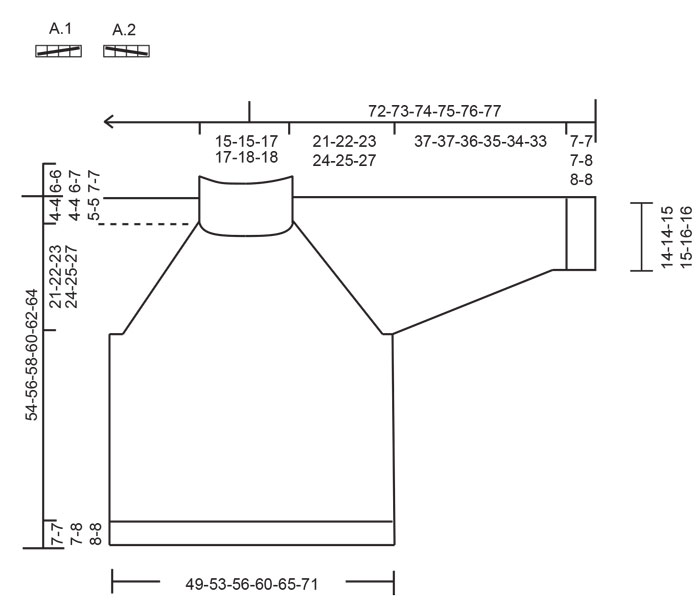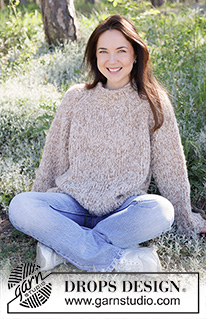Comments / Questions (8)
![]() Diana Johansen wrote:
Diana Johansen wrote:
Hej, Synes ikke jeg kan læse hvor ofte jeg skal sno, hvor mange pinde skal strikkes mellem hver snoninger. Mvh Diana
24.03.2025 - 19:03DROPS Design answered:
Hej Diana, der snos kun den ene gang som er beskrevet i opskriften :)
27.03.2025 - 12:12
![]() Micheline Lebeau* wrote:
Micheline Lebeau* wrote:
A1 et A2 doivent ils être effectués tous les tours
29.12.2024 - 19:44DROPS Design answered:
Bonjour Mme Lebeau, les diagrammes A.1 et A.2 ne sont tricotés qu'une seule fois, à la fin du col. Bon tricot!
02.01.2025 - 14:22
![]() Mary Angela Kärreberg wrote:
Mary Angela Kärreberg wrote:
Hej, Jag undrar kring flätorna. Det står i HALSKANT att man stickar 1 varv med fläta, A1 och A2 men nämns inte om det ska upprepas igen i oket. Frågan är, ska jag fläta varje varv när jag stickar raglan i oket eller är den enbart 1 gång i halskanten? Mvh Mary
30.11.2024 - 12:07DROPS Design answered:
Hei Mary. Du strikker bare fletten 1 gang (i halskanten). mvh DROPS Design
02.12.2024 - 10:18
![]() Irene Andreassen wrote:
Irene Andreassen wrote:
Str L er oppført med 200 masker når bærestykket er ferdig og det skal deles til bol og ermer. Hvis jeg følger oppskriften har jeg 40 m på hvert erme og 58 m på for- og bakstykke. Det blir totalt 196 masker og jeg har da 4 masker til overs. Er det korrekt med 58 masker på for og bakstykke, eller skal det kanskje være 60 masker?
21.11.2024 - 08:16DROPS Design answered:
Hei Irene. Ja, her burde det kanskje ha vært 60 masker på fram -og bakstykket. Oppskriften er oversendt Design avd. for en dobbeltsjekk og de vil evnt komme med en oppdatering av oppskriften. mvh DROPS Design
25.11.2024 - 10:01
![]() Irene Andreassen wrote:
Irene Andreassen wrote:
Jeg strikker str L, og har 200 masker før oppdeling til bol og ermer. Får det ikke til å stemme med maskeantallet som er oppført for str L, det virker som om det totalt blir 196 masker og ikke 200.
17.11.2024 - 23:50
![]() Karin Weber wrote:
Karin Weber wrote:
Die Maschenzahl des Ärmels beträgt vor dem Rippenbündchen 36M.Dann heißt es Rippenmuster stricken und gleichzeitig in der 1. Runde 4 Maschen gleichmäßig verteilt abnehmen = 40 Maschen??????? Also abnehmen oder zunehmen??? Vielen Dank für Ihre freundliche und Schnelle Hilfe. Karin Weber
03.11.2024 - 12:38DROPS Design answered:
Liebe Frau Weber, hier sollte man zunehmen (von 36 auf 40 Maschen), deutsche Anleitung wird korrigiert, danke für den Hinweis. Viel Spaß beim Stricken!
04.11.2024 - 09:15
![]() Karin Weber wrote:
Karin Weber wrote:
Bei der Halsblende wird angegeben nach 7 cm Länge: 4 Maschen für den Ärmel, 18 M Vorderteil, 4M Ärmel, 18 Maschen Rückenteil. Aber Anschlag 60 M.????????
29.10.2024 - 17:31DROPS Design answered:
Liebe Frau Weber, ja genau und dazu die 4 Maschen für die Diagramme A.1 und A.2 für die Raglanmaachen, dh A.1 (= 4 M), 4 Maschen glatt rechts (= Ärmel), A.2 (=4 M), 18 Maschen glatt rechts (= Vorderteil), A.1 (= 4 M), 4 Maschen glatt rechts (= Ärmel), A.2 (=4 M), 18 Maschen glatt rechts (= Rückenteil) = 4+4+4+18+4+4+4+18=60 Maschen. Viel Spaß beim Stricken!
30.10.2024 - 07:38
![]() Botrel wrote:
Botrel wrote:
Je ne comprends pas comment augmenter de 1 maille avant et après le fil marqueur en faisant 1 jeté ???
28.10.2024 - 20:30DROPS Design answered:
Bonjour Mme Bretel, pour augmenter, on fait 1 jeté que l'on tricote torse au tour suivant, les augmentations du raglan se font avant et/ou après A.1/A.2, les fils marqueurs se trouvent au milieu des torsades. Continuez les torsades et augmentez soit de chaque côté de chacune des torsades soit avant/après ainsi. Bon tricot!
29.10.2024 - 09:12
Almond Bliss#almondblisssweater |
|||||||
 |
 |
||||||
Knitted jumper in 1 strand DROPS Alpaca Bouclé and 1 strand DROPS Brushed Alpaca Silk. The piece is worked top down with raglan. Sizes XS - XXL.
DROPS 255-39 |
|||||||
|
------------------------------------------------------- EXPLANATIONS FOR THE PATTERN: ------------------------------------------------------- PATTERN: See diagrams A.1 and A.2. RAGLAN: Increase 1 stitch by making 1 yarn over, which is knitted twisted on the next round to avoid a hole. The new stitches are continued in stocking stitch. DECREASE TIP: Decrease 1 stitch on each side of the marker-thread as follows: Work until there are 3 stitches left before the marker-thread, knit 2 together, knit 2 (marker-thread sits between these 2 stitches), slip 1 stitch knit-wise, knit 1 and pass the slipped stitch over the knitted stitch (2 stitches decreased). ------------------------------------------------------- START THE PIECE HERE: ------------------------------------------------------- JUMPER – SHORT OVERVIEW OF THE PIECE: The pattern uses both long and short needles; start with the length which fits the number of stitches and change when necessary. The neck and yoke are worked in the round with circular needle, top down and from the right back shoulder. When the yoke is finished, it is divided for the body and sleeves and the body continued in the round, while the sleeves wait. The sleeves are worked top down, in the round. NECK: Cast on 56-56-60-60-68-68 stitches with circular needle size 8 mm, 1 strand DROPS Alpaca Bouclé and 1 strand DROPS Brushed Alpaca Silk (= 2 strands). Change to circular needle size 7 mm. Work 4 rounds stocking stitch, 2 rounds rib (knit 2, purl 2), then work stocking stitch until the neck measures 6-6-6-7-7-7 cm. Now work 1 round of cables as follows: Work A.1, then 4-4-4-4-8-8 stocking stitches (= sleeve), A.2, then 16-16-18-18-18-18 stocking stitches (= front piece), A.1, then 4-4-4-4-8-8 stocking stitches (= sleeve), A.2, then 16-16-18-18-18-18 stocking stitches (= back piece). The round begins on the back right shoulder. Insert 1 marker after the first 20-20-21-21-25-25 stitches (approx. mid-front), The piece is now measured from here. YOKE: Change to circular needle size 8 mm. Insert 4 marker-threads, without working the stitches, the threads inserted in the middle of the 4 stitches in each A.1/A.2. There are 8-8-8-8-12-12 stitches on each sleeve and 20-20-22-22-22-22 stitches on the front and back pieces. Continue in the round with stocking stitch, increasing for RAGLAN on each side of the 4 stitches with the marker-threads – read description above. Increase for raglan before/after the 4 stitches , in each transition between the body and sleeves every 2nd round a total of 9-12-13-17-17-19 times = 128-152-164-196-204-220 stitches (= 8 stitches increased on each increase-round). Remember to maintain the knitting tension. Continue increasing as follows: Increase for raglan every 2nd round on the front and back pieces and every 4th round on the sleeves (alternately 4 and 8 increased stitches). Work these increases a total of 6-4-4-1-1-1 times on the front and back pieces; 3-2-2-0-0-0 times on the sleeves. After the last increase there are 164-176-188-200-208-224 stitches and the yoke measures approx. 20-21-23-24-24-27 cm from the marker. Continue working without further increases until the yoke measures 21-22-23-24-25-27 cm from the marker. DIVIDE FOR BODY AND SLEEVES: On the next round work as follows: Knit 0-0-0-1-3-4 (belong to back piece), place the next 32-36-38-40-40-42 stitches on a thread for the sleeve, cast on 4-6-6-6-8-8 stitches (in side mid-under sleeve), knit 50-52-56-60-64-70 (= front piece), place the next 32-36-38-40-40-42 stitches on a thread for the sleeve, cast on 4-6-6-6-8-8 stitches (in side mid-under sleeve), knit the last 48-50-54-59-61-66 stitches (= back piece). The body and sleeves are finished separately. The beginning of the round is now mid-under sleeve. BODY: = 108-116-124-132-144-156 stitches. Continue stocking stitch in the round until the piece measures 43-45-47-48-49-51 cm from the marker. Change to circular needle size 7 mm. Work rib (knit 2, purl 2), AT THE SAME TIME increase 12 stitches evenly on the first round = 120-128-136-144-156-168 stitches. Work rib for 7-7-7-8-8-8 cm, knit 4 rounds, then cast off slightly loosely with knit. The jumper measures approx. 50-52-54-56-57-59 cm from the marker and 54-56-58-60-62-64 cm from top of shoulder. SLEEVES: Place the 32-36-38-40-40-42 sleeve-stitches from the thread on one side of the piece on circular needle size 8 mm and knit up 1 stitch in each of the 4-6-6-6-8-8 stitches cast on under the sleeve = 36-42-44-46-48-50 stitches. Insert a marker-thread in the middle of the 4-6-6-6-8-8 stitches under the sleeve. Start at the marker-thread and work stocking stitch in the round. When the sleeve measures 3-4-4-4-4-4 cm, decrease 2 stitches under the sleeve – read DECREASE TIP. Decrease like this every 11-5-5-5-5-4 cm a total of 3-6-6-6-6-7 times = 30-30-32-34-36-36 stitches. Continue working until the sleeve measures 37-37-36-35-34-33 cm from the division. Change to double pointed needles size 7 mm. Work rib (knit 2, purl 2), AT THE SAME TIME increase 2-2-4-2-4-4 stitches evenly on the first round = 32-32-36-36-36-40-40 stitches. When the rib measures 7-7-7-8-8-8 cm, knit 4 rounds, then cast off a little loosely with knit. The sleeve measures approx. 44-44-43-43-42-41 cm. |
|||||||
Diagram explanations |
|||||||
|
|||||||

|
|||||||
Have you finished this pattern?Tag your pictures with #dropspattern #almondblisssweater or submit them to the #dropsfan gallery. Do you need help with this pattern?You'll find 29 tutorial videos, a Comments/Questions area and more by visiting the pattern on garnstudio.com. © 1982-2025 DROPS Design A/S. We reserve all rights. This document, including all its sub-sections, has copyrights. Read more about what you can do with our patterns at the bottom of each pattern on our site. |
|||||||












































































Post a comment to pattern DROPS 255-39
We would love to hear what you have to say about this pattern!
If you want to leave a question, please make sure you select the correct category in the form below, to speed up the answering process. Required fields are marked *.